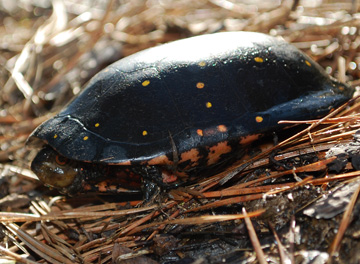Clarks Landing Road, Port Republic, NJ
Phone: (609) 984-1339
nj.gov/dep/njnlt/clarkslanding.htm
New Jersey Natural Lands Trust
Exit Port Republic WMA and turn Left onto Sooys Landing Road, then Right onto Clark’s Landing Road. After 2.5 miles, park on the Right at the trailhead where Natural Lands Trust Signs mark the entrance to Clarks Landing Preserve, across from Leipzig Avenue. DIRECTIONS FROM NEAREST HIGHWAY: From the intersection of Route 30 and Route 50 in Egg Harbor City, continue West on Route 30/ White Horse Pike. After 3.1 miles, turn Left on Leipzig Avenue. After 5 miles, continue across Clarks Landing Road into the roadside parking area for Clarks Landing Preserve. Map
Open daily from dawn to dusk. Minimal roadside parking. Trails are not maintained or well marked, may be overgrown or flooded in certain areas. Hunting in season. Wear blaze orange or other bright colors for safety. Additional stop & scan points along Mannheim Avenue, which is accessible from Clarks Landing Road, 0.8 miles Southeast of Leipzig Avenue on the Left.
 |
| Spotted Turtle | Tony Geiger |
| |
| | Clarks Landing Preserve consists of mixed pine/oak uplands and cedar lowlands meeting with brackish and saltwater wetlands along the Mullica River. A sand trail reaches about a half mile into the preserve before disappearing into the dense, rich coastal forest that makes this river corridor so appealing to migrant birds, amphibians, and other wildlife.
Visit in April or May after rains to catch glimpses of reptiles and amphibians in the vernal pools along the trail across from Leipzig Avenue.
Wintering birds include White-breasted Nuthatch, Tufted Titmouse, Hairy Woodpecker, Downy Woodpecker, Junco and White-throated Sparrow. Less common winter birds to keep an eye out for are Cedar Waxwing, Yellow-rumped Warbler, Hermit Thrush, Yellow-bellied Sapsucker and Red-headed Woodpecker. Scan the salt marsh at the end of Mannheim Avenue for Bald Eagle, Great Blue Heron and Northern Harrier. Watch for Short-eared Owls over the marsh at dusk and listen for Great Horned, Barred and Screech Owls in the woods after dark along Mannheim Avenue.
On mornings in late April and early May, look closely around the vernal pools along the trail at Leipzig Avenue for amphibians such as spring peeper, Fowler’s toad, carpenter frog and cricket frog. Listen for gray and Pine Barrens treefrogs in the cedar swamps. Spring migrant songbirds include Pine Warbler, Blue-winged Warbler, Northern Parula and Rose-breasted Grosbeak. Tree Swallows, Purple Martins and wading birds are active along the river.
The understory is thick with blooming laurels and blueberry bushes along the upland trail at Leipzig Road. Ferns cover the lowlands, and pitcher plants peek from mossy hummocks in the cedar swamps. Look for spotted, painted, snapping, and box turtles crossing the trail as they seek nesting sites. Dragonflies and damselflies emerge from the cedar swamps. Nesting birds include Eastern Towhee, Brown Thrasher, Gray Catbird, Eastern Kingbird, and Red-eyed Vireo. Watch for snakes such as black rat snake and pine snake along the sand roads. Listen at dusk for King Rail and Sora along Mannheim Avenue, and watch for brown bats swooping overhead. Insect repellant recommended.
Migrant songbirds such as Blackpoll Warbler, American Redstart and Black-and-White Warbler move through the woods. Great Egrets, Snowy Egrets and Black-crowned Night-Herons are still active along the river. Osprey and Bald Eagles circle overhead. Waterfowl such as Black Duck, Common Merganser, Ruddy Duck, and Green-winged Teal stop to rest and feed in the marsh.
|